2018 KIA RIO brake
[x] Cancel search: brakePage 432 of 490
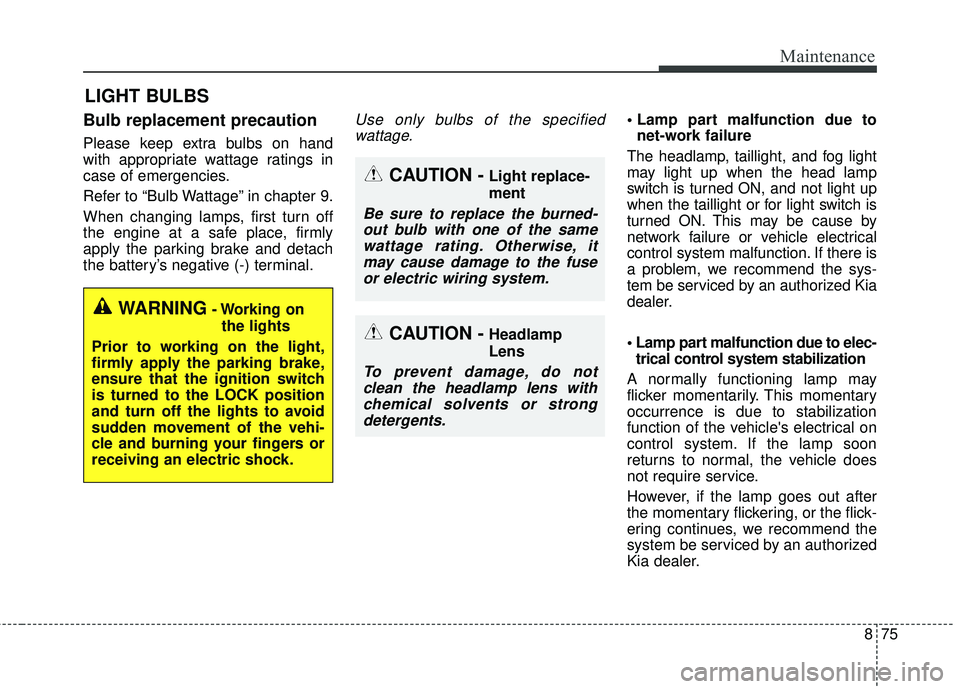
875
Maintenance
LIGHT BULBS
Bulb replacement precaution
Please keep extra bulbs on hand
with appropriate wattage ratings in
case of emergencies.
Refer to “Bulb Wattage” in chapter 9.
When changing lamps, first turn off
the engine at a safe place, firmly
apply the parking brake and detach
the battery’s negative (-) terminal.
Use only bulbs of the specifiedwattage. net-work failure
The headlamp, taillight, and fog light
may light up when the head lamp
switch is turned ON, and not light up
when the taillight or for light switch is
turned ON. This may be cause by
network failure or vehicle electrical
control system malfunction. If there is
a problem, we recommend the sys-
tem be serviced by an authorized Kia
dealer.
trical control system stabilization
A normally functioning lamp may
flicker momentarily. This momentary
occurrence is due to stabilization
function of the vehicle's electrical on
control system. If the lamp soon
returns to normal, the vehicle does
not require service.
However, if the lamp goes out after
the momentary flickering, or the flick-
ering continues, we recommend the
system be serviced by an authorized
Kia dealer.
WARNING- Working on the lights
Prior to working on the light,
firmly apply the parking brake,
ensure that the ignition switch
is turned to the LOCK position
and turn off the lights to avoid
sudden movement of the vehi-
cle and burning your fingers or
receiving an electric shock.
CAUTION -Light replace-
ment
Be sure to replace the burned- out bulb with one of the samewattage rating. Otherwise, itmay cause damage to the fuseor electric wiring system.
CAUTION -Headlamp
Lens
To prevent damage, do notclean the headlamp lens withchemical solvents or strongdetergents.
Page 458 of 490
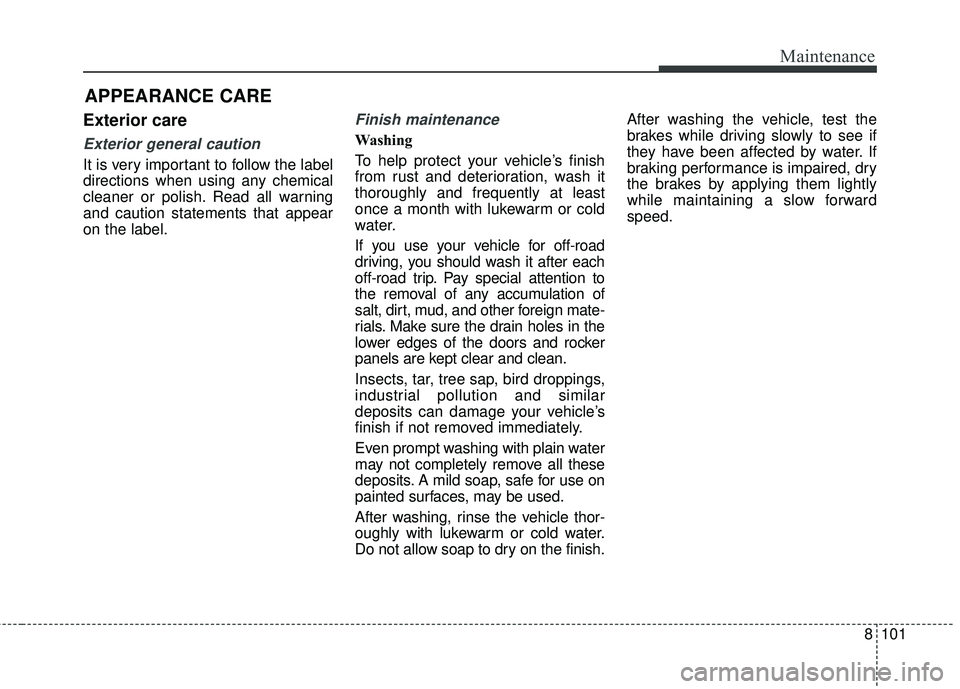
8101
Maintenance
APPEARANCE CARE
Exterior care
Exterior general caution
It is very important to follow the label
directions when using any chemical
cleaner or polish. Read all warning
and caution statements that appear
on the label.
Finish maintenance
Washing
To help protect your vehicle’s finish
from rust and deterioration, wash it
thoroughly and frequently at least
once a month with lukewarm or cold
water.
If you use your vehicle for off-road
driving, you should wash it after each
off-road trip. Pay special attention to
the removal of any accumulation of
salt, dirt, mud, and other foreign mate-
rials. Make sure the drain holes in the
lower edges of the doors and rocker
panels are kept clear and clean.
Insects, tar, tree sap, bird droppings,
industrial pollution and similar
deposits can damage your vehicle’s
finish if not removed immediately.
Even prompt washing with plain water
may not completely remove all these
deposits. A mild soap, safe for use on
painted surfaces, may be used.
After washing, rinse the vehicle thor-
oughly with lukewarm or cold water.
Do not allow soap to dry on the finish.After washing the vehicle, test the
brakes while driving slowly to see if
they have been affected by water. If
braking performance is impaired, dry
the brakes by applying them lightly
while maintaining a slow forward
speed.
Page 461 of 490
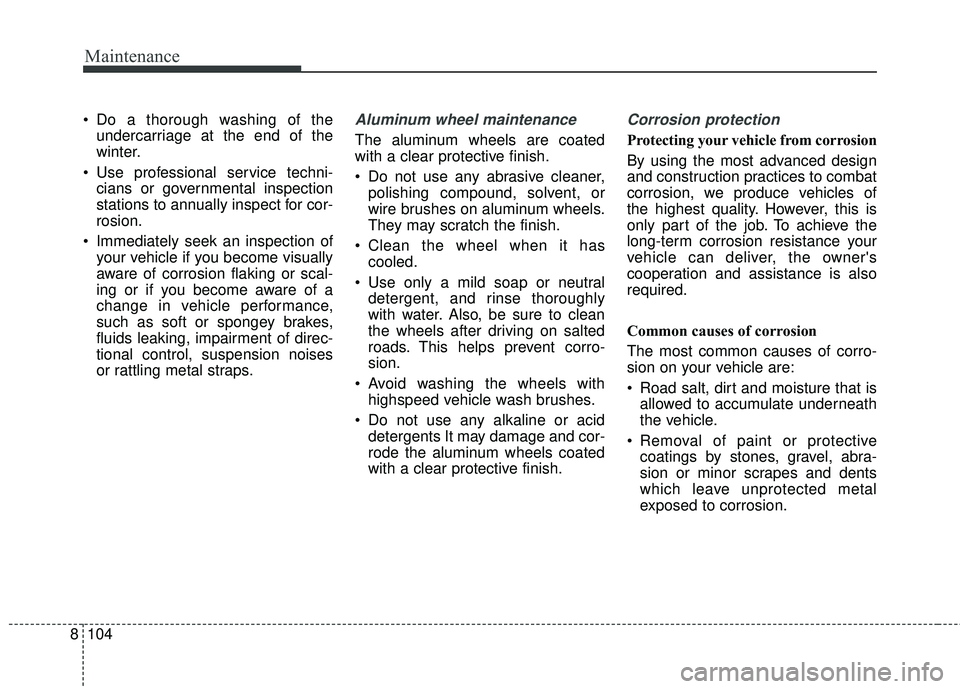
Maintenance
104
8
Do a thorough washing of the
undercarriage at the end of the
winter.
Use professional service techni- cians or governmental inspection
stations to annually inspect for cor-
rosion.
Immediately seek an inspection of your vehicle if you become visually
aware of corrosion flaking or scal-
ing or if you become aware of a
change in vehicle performance,
such as soft or spongey brakes,
fluids leaking, impairment of direc-
tional control, suspension noises
or rattling metal straps.Aluminum wheel maintenance
The aluminum wheels are coated
with a clear protective finish.
Do not use any abrasive cleaner,polishing compound, solvent, or
wire brushes on aluminum wheels.
They may scratch the finish.
Clean the wheel when it has cooled.
Use only a mild soap or neutral detergent, and rinse thoroughly
with water. Also, be sure to clean
the wheels after driving on salted
roads. This helps prevent corro-
sion.
Avoid washing the wheels with highspeed vehicle wash brushes.
Do not use any alkaline or acid detergents It may damage and cor-
rode the aluminum wheels coated
with a clear protective finish.
Corrosion protection
Protecting your vehicle from corrosion
By using the most advanced design
and construction practices to combat
corrosion, we produce vehicles of
the highest quality. However, this is
only part of the job. To achieve the
long-term corrosion resistance your
vehicle can deliver, the owner's
cooperation and assistance is also
required.
Common causes of corrosion
The most common causes of corro-
sion on your vehicle are:
Road salt, dirt and moisture that isallowed to accumulate underneath
the vehicle.
Removal of paint or protective coatings by stones, gravel, abra-
sion or minor scrapes and dents
which leave unprotected metal
exposed to corrosion.
Page 477 of 490
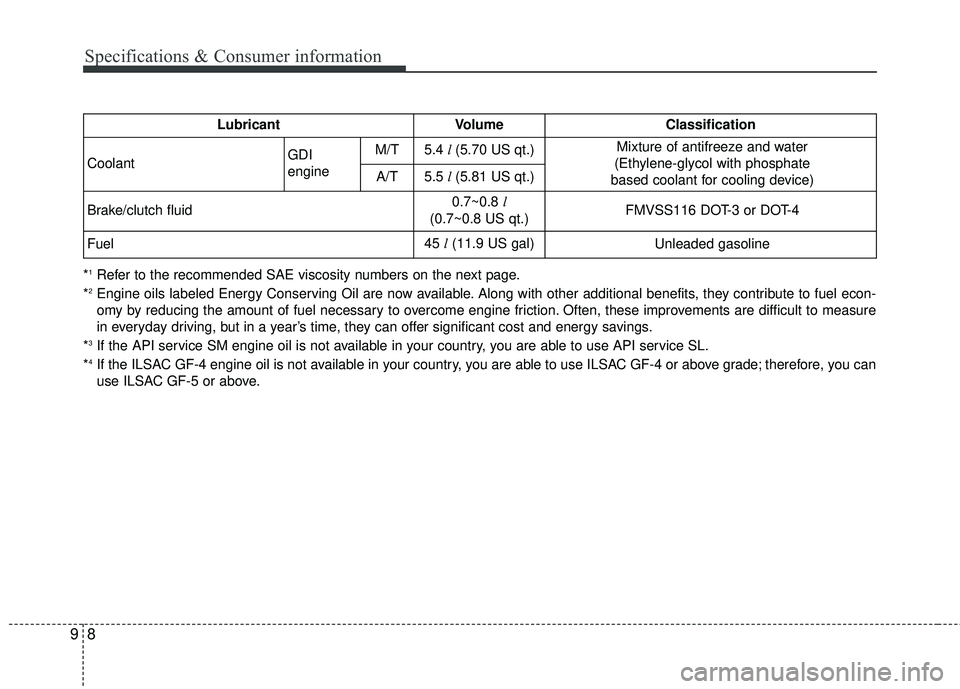
Specifications & Consumer information
89
*1Refer to the recommended SAE viscosity numbers on the next page.
*2Engine oils labeled Energy Conserving Oil are now available. Along with other additional benefits, they contribute to fuel econ-
omy by reducing the amount of fuel necessary to overcome engine friction. Often, these improvements are difficult to measure
in everyday driving, but in a year’s time, they can offer significant cost and energy savings.
*
3If the API service SM engine oil is not available in your country, you are able to use API service SL.
*4If the ILSAC GF-4 engine oil is not available in your country, you are able to use ILSAC GF-4 or above grade; therefore, you can
use ILSAC GF-5 or above.
LubricantVolumeClassification
Coolant GDI
engineM/T5.4 l (5.70 US qt.)Mixture of antifreeze and water
(Ethylene-glycol with phosphate
based coolant for cooling device)
A/T5.5 l (5.81 US qt.)
Brake/clutch fluid0.7~0.8 l
(0.7~0.8 US qt.)FMVSS116 DOT-3 or DOT-4
Fuel45 l(11.9 US gal)Unleaded gasoline
Page 482 of 490
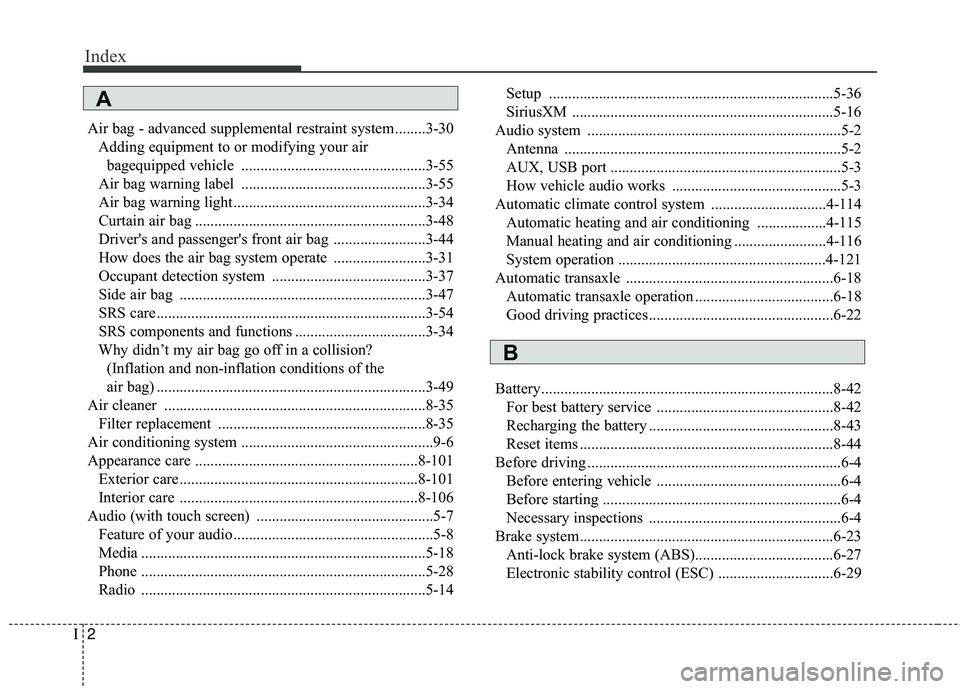
Index
2I
Air bag - advanced supplemental restraint system ........3-30Adding equipment to or modifying your air bagequipped vehicle ................................................3-55
Air bag warning label ................................................3-55
Air bag warning light ..................................................3-34
Curtain air bag ............................................................3-48
Driver's and passenger's front air bag ........................3-44
How does the air bag system operate ........................3-31
Occupant detection system ........................................3-37
Side air bag ................................................................3-47
SRS care ......................................................................3-\
54
SRS components and functions ..................................3-34
Why didn’t my air bag go off in a collision? (Inflation and non-inflation conditions of the
air bag) ......................................................................3-\
49
Air cleaner ....................................................................8-35\
Filter replacement ......................................................8-35
Air conditioning system ..................................................9-6
Appearance care ..........................................................8-101 Exterior care ..............................................................8-101
Interior care ..............................................................8-106
Audio (with touch screen) ..............................................5-7 Feature of your audio ....................................................5-8
Media ........................................................................\
..5-18
Phone ........................................................................\
..5-28
Radio ........................................................................\
..5-14 Setup ........................................................................\
..5-36
SiriusXM ....................................................................5-16\
Audio system ..................................................................5-2 Antenna ........................................................................\
5-2
AUX, USB port ............................................................5-3
How vehicle audio works ............................................5-3
Automatic climate control system ..............................4-114 Automatic heating and air conditioning ..................4-115
Manual heating and air conditioning ........................4-116
System operation ......................................................4-121
Automatic transaxle ......................................................6-18 Automatic transaxle operation ....................................6-18
Good driving practices ................................................6-22
Battery........................................................................\
....8-42 For best battery service ..............................................8-42
Recharging the battery ................................................8-43
Reset items ..................................................................8-44
Before driving ..................................................................6-4 Before entering vehicle ................................................6-4
Before starting ..............................................................6-4
Necessary inspections ..................................................6-4
Brake system..................................................................6-23 Anti-lock brake system (ABS)....................................6-27
Electronic stability control (ESC) ..............................6-29
A
B
Page 483 of 490
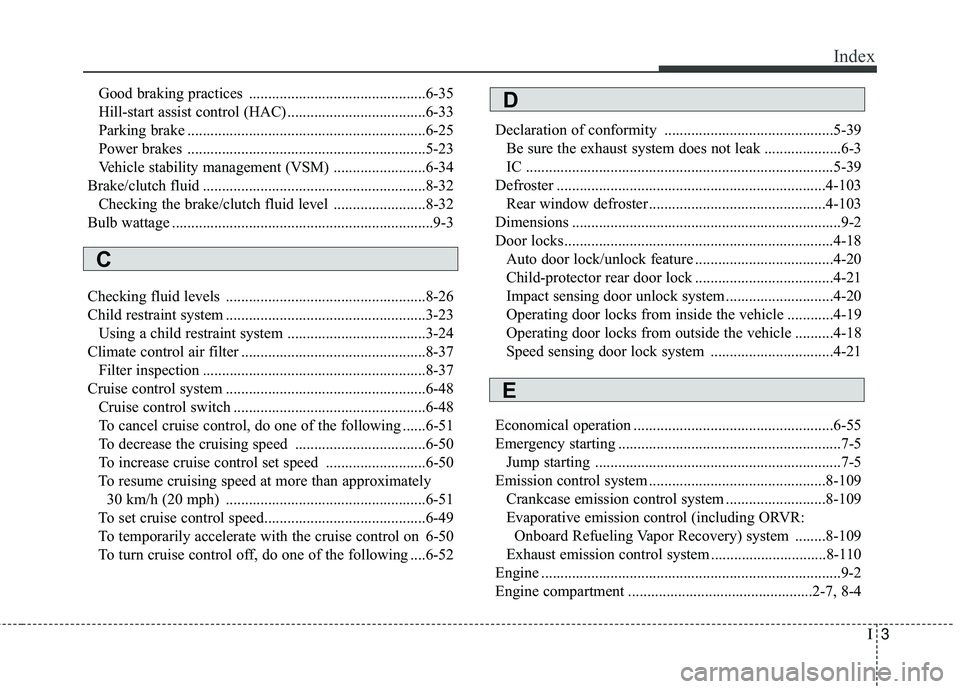
I3
Index
Good braking practices ..............................................6-35
Hill-start assist control (HAC) ....................................6-33
Parking brake ..............................................................6-25
Power brakes ..............................................................5-23
Vehicle stability management (VSM) ........................6-34
Brake/clutch fluid ..........................................................8-32 Checking the brake/clutch fluid level ........................8-32
Bulb wattage ....................................................................9-3
Checking fluid levels ....................................................8-26
Child restraint system ....................................................3-23 Using a child restraint system ....................................3-24
Climate control air filter ................................................8-37 Filter inspection ..........................................................8-37
Cruise control system ....................................................6-48 Cruise control switch ..................................................6-48
To cancel cruise control, do one of the following ......6-51
To decrease the cruising speed ..................................6-50
To increase cruise control set speed ..........................6-50
To resume cruising speed at more than approximately 30 km/h (20 mph) ....................................................6-51
To set cruise control speed..........................................6-49
To temporarily accelerate with the cruise control on 6-50
To turn cruise control off, do one of the following ....6-52 Declaration of conformity ............................................5-39
Be sure the exhaust system does not leak ....................6-3
IC ........................................................................\
........5-39
Defroster ......................................................................4-\
103 Rear window defroster ..............................................4-103
Dimensions ......................................................................9-\
2
Door locks......................................................................4-\
18 Auto door lock/unlock feature ....................................4-20
Child-protector rear door lock ....................................4-21
Impact sensing door unlock system ............................4-20
Operating door locks from inside the vehicle ............4-19
Operating door locks from outside the vehicle ..........4-18
Speed sensing door lock system ................................4-21
Economical operation ....................................................6-55
Emergency starting ..........................................................7-5 Jump starting ................................................................7-5
Emission control system ..............................................8-109 Crankcase emission control system ..........................8-109
Evaporative emission control (including ORVR: Onboard Refueling Vapor Recovery) system ........8-109
Exhaust emission control system ..............................8-110
Engine ........................................................................\
......9-2
Engine compartment ................................................2-7, 8-4
C
D
E
Page 487 of 490

I7
Index
Owner maintenance ........................................................8-7Owner maintenance schedule ......................................8-7
Parking brake ................................................................8-34 Checking the parking brake ........................................8-34
Radar type autonomous emergency braking ................6-37 AEB warning message and system control ................6-39
Brake operation ..........................................................6-40
Limitation of the system ............................................6-43
System malfunction ....................................................6-42
System setting and activation ....................................6-37
Rearview camera ..........................................................4-86
Recommended lubricants and capacities ........................9-7 Recommended SAE viscosity number ........................9-9
Remote keyless entry ......................................................4-9 Battery replacement ....................................................4-11
Immobilizer system ....................................................4-13
Remote keyless entry system operations ......................4-9
Transmitter precautions ..............................................4-10
Road warning ..................................................................7-2 Hazard warning flasher ................................................7-2 Scheduled maintenance service ......................................8-9
Seat ........................................................................\
..........3-2
Driver’s seat ..................................................................3-2
Front passenger’s seat ..................................................3-2
Front seat adjustment ....................................................3-4
Headrest (for front seat) ................................................3-6
Rear seat ........................................................................\
3-2
Rear seat adjustment ....................................................3-9
Seatback pocket ............................................................3-8
Seat belts ........................................................................\
3-12 Care of seat belts ........................................................3-22
Pre-tensioner seat belt ................................................3-17
Seat belt precautions ..................................................3-20
Seat belt restraint system ............................................3-12
Smart key ........................................................................\
4-6 Smart key functions ......................................................4-6
Smart key precautions ..................................................4-7
Smart trunk (for 4 door) ................................................4-24
Special driving conditions ............................................6-57 Driving at night ..........................................................6-59
Driving in flooded areas ............................................6-60
Driving in the rain ......................................................6-59
Driving off-road ..........................................................6-60
Hazardous driving conditions ....................................6-57
Highway driving ........................................................6-60
O
P
S
R
Page 490 of 490

Index
10I
Winter driving ................................................................6-62Carry emergency equipment ......................................6-64
Change to “winter weight” oil if necessary ................6-63
Check battery and cables ............................................6-63
Check spark plugs and ignition system ......................6-63
Don't let ice and snow accumulate underneath ..........6-64
Don't let your parking brake freeze ............................6-64
Snowy or Icy conditions ............................................6-62
To keep locks from freezing ......................................6-63
Use approved window washer anti-freeze in system 6-63
Use high quality ethylene glycol coolant ..................6-63
Wiper blades ..................................................................8-39 Blade inspection ..........................................................8-39
Blade replacement ......................................................8-39
Wipers and washers ......................................................4-93 Rear window wiper and washer switch (5 door) ........4-96
Windshield washers (Front) ........................................4-95
Windshield wipers ......................................................4-94